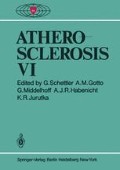Abstract
It is well-recognized that the level of serum cholesterol can be lowered significantly in human subjects by substituting polyunsaturated fat for saturated fat in their diet (1–3). Since a high level of serum cholesterol is considered to be a major risk factor for cardiovascular disease, individuals with elevated serum cholesterol are often advised to decrease their intake of saturated fat and to eat more polyunsaturated fat. A change in this direction was also recommended for the population of the United States as a whole in the Dietary Guidelines prepared by a Select Committee of the United States Senate. These Guidelines suggested that dietary fat intake be reduced to 30% of calories and that the proportions be altered so as to provide approximately equal amounts of polyunsaturated, monounsaturated, and saturated fat (4).
Supported by the National Cancer Institute of Canada
Access this chapter
Tax calculation will be finalised at checkout
Purchases are for personal use only
Preview
Unable to display preview. Download preview PDF.
References
Kinsell LW (1963) Relationship of dietary fats to atherosclerosis. Progr Chem Fats & Other Lipids 6: 137–170
McGandy RB, Hegsted DM (1975) Quantitative effects of dietary fat and cholesterol on serum cholesterol in man. In: Vergroesen AJ (ed) The Role of Fats in Human Nutrition, Acad Press, NY. pp 211–230
Grundy SM (1975) Effects of polyunsaturated fats on lipid metabolism in patients with hypertriglyceridemia. J Clin Invest 55: 269–282
Select Committee on Nutrition and Human Needs, United States Senate (1977) Dietary Goals for the United States, Second Edition, U.S. Government Printing Office, Washington, DC
Oliver MF (1981) Serum cholesterol - The knave of hearts and the joker. Lancet 2: 1090–1095
Carroll KK, Khor HT (1971) Effects of level and type of dietary fat on incidence of mammary tumors induced in female Sprague-Dawley rats by 7,12-dimethylbenz(α)anthracene. Lipids 6: 415–420
Roebuck BD, Yager JD, Jr, Longnecker DS, Wilpone SA (1981) Promotion by unsaturated fat of azaserine-induced pancreatic carcinogenesis in the rat. Cancer Res 41: 3961–3966
Reddy BS, Cohen LA, McCoy GD, Hill P, Weisburger JH, Wynder EL (1980) Nutrition and its relationship to cancer. Adv Cancer Res 32: 237–345
Carroll KK, Hopkins GJ (1979) Dietary polyunsaturated fat versus saturated fat in relation to mammary carcinogenesis. Lipids 14: 155–158
Carroll KK, Hopkins GJ, Kennedy TG, Davidson MB (1981) Essential fatty acids in relation to mammary carcinogenesis. Progr Lipid Res 20: 685–690
Carroll KK, Davidson MB (1982) The role of lipids in tumorigenesis. In: Arnott MS, van Eys J, Wang Y-M (eds) Molecular Interrelations of Nutrition and Cancer, Raven Press, NY, pp 237–245
Carroll KK, Khor HT (1975) Dietary fat in relation to tumorigenesis. Progr Biochem Pharmacol 10: 308–353
Segi M, Hattori H, Segi R (1980) Age-adjusted death rates for cancer for selected sites (A-classification) in 46 countries in 1975. Segi Institute of Cancer Epidemiology3 Nagoya, Japan
Food Balance Sheets - 1975–77 Average and Per Caput Food Supplies - 1961–65 Average, 1967 to 1977 (1980) Food and Agriculture Organization of the United Nations, Rome
Cruse P, Lewin M, Clark CG (1979) Dietary cholesterol is co-carcinogenic for human colon cancer. Lancet 1: 752–755
Liu K, Moss D, Persky V, Stamler J, Garside D, Soltero I (1979) Dietary cholesterol, fat, and fibre, and colon-cancer mortality. Lancet 2: 782–785
Reddy, BS (1981) Dietary fat and its relationship to large bowel cancer. Cancer Res 41: 3700–3705
Nigro, ND (1981) Animal studies implicating fat and fecal steroids in intestinal cancer. Cancer Res 41: 3769–3770
Nigro ND, Campbell RL, Gantt JS, Lin YN, Singh DV (1977) A comparison of the effects of the hypocholesteremic agents, cholestyramine and candicidin, on the induction of intestinal tumors in rats by azoxymethane. Cancer Res 37: 3198–3203
Reddy BS, Watanabe K (1979) Effect of cholesterol metabolites and promoting effect of lithocholic acid in colon carcinogenesis in germ-free and conventional F344 rats. Cancer Res 39: 1521–1524
Quintao E, Grundy SM, Ahrens EH Jr. (1971) Effects of dietary cholesterol on the regulation of total body cholesterol in man. J Lipid Res 12: 233–247
Myant NB (1981) The biology of cholesterol and related steroids. William Heinemann Medical Books Ltd. London, pp. 481–484
Lin DS, Connor WE (198O) The long term effects of dietary cholesterol upon the plasma lipids, lipoproteins, cholesterol absorpsion and the sterol balance in man: the demonstration of feedback inhibition of cholesterol biosynthesis and increased bile acid excretion. J Lipid Res 21: 1042–1052
Lilienfeld AM (1981) The Humean fog: Cancer and cholesterol. Am J Epidemiol 114: 1–4
Feinleib M (1981) On a possible inverse relationship between serum cholesterol and cancer mortality. Am J Epidemiol 114: 5–10
Heller RF (1981) Coronary heart disease, cancer, lipoproteins, and the effects of clofibrate: Is enzyme induction a common link and are lipoproteins red herrings? Lancet 2: 1258–1260
Broitman SA (1981) Cholesterol excretion and colon cancer. Cancer Res 41: 3738–3740
Dyer AR, Stamler J, Paul 0, Shekelle RB, Schoenberger JA, Berkson DM, Lepper M, Collette P, Shekelle S, Lindberg HA (1981) Serum cholesterol and risk of death from cancer and other causes in three Chicago epidemiological studies. J Chron Dis 34: 249–260
Editor information
Editors and Affiliations
Rights and permissions
Copyright information
© 1983 Springer-Verlag Berlin Heidelberg
About this paper
Cite this paper
Carroll, K.K. (1983). Diet and Carcinogenesis. In: Schettler, F.G., Gotto, A.M., Middelhoff, G., Habenicht, A.J.R., Jurutka, K.R. (eds) Atherosclerosis VI. Springer, Berlin, Heidelberg. https://doi.org/10.1007/978-3-642-81817-2_41
Download citation
DOI: https://doi.org/10.1007/978-3-642-81817-2_41
Publisher Name: Springer, Berlin, Heidelberg
Print ISBN: 978-3-642-81819-6
Online ISBN: 978-3-642-81817-2
eBook Packages: Springer Book Archive

